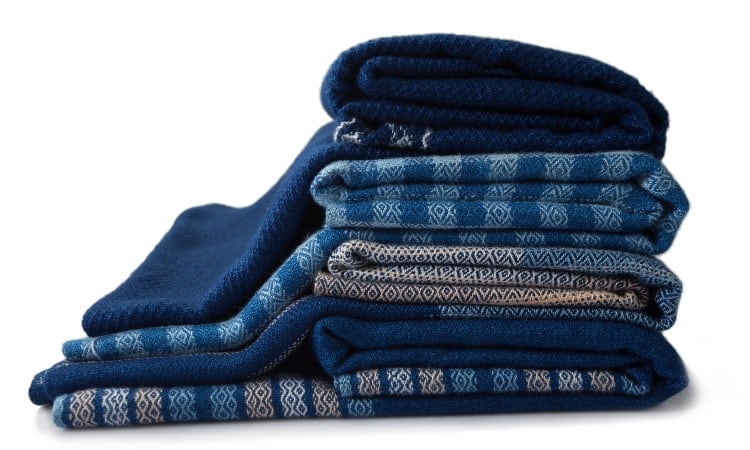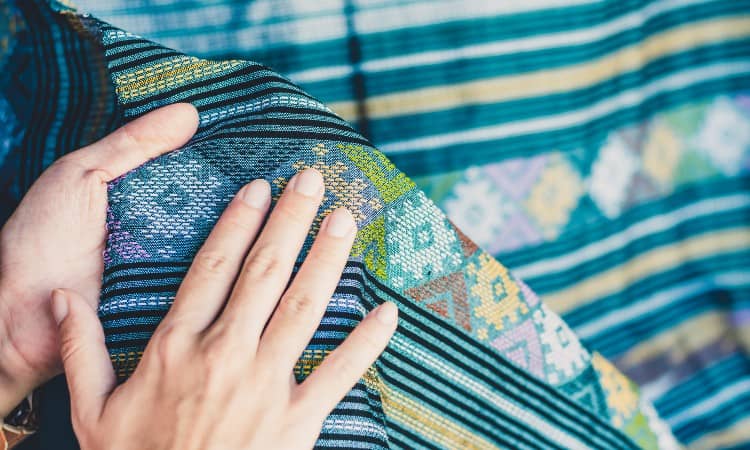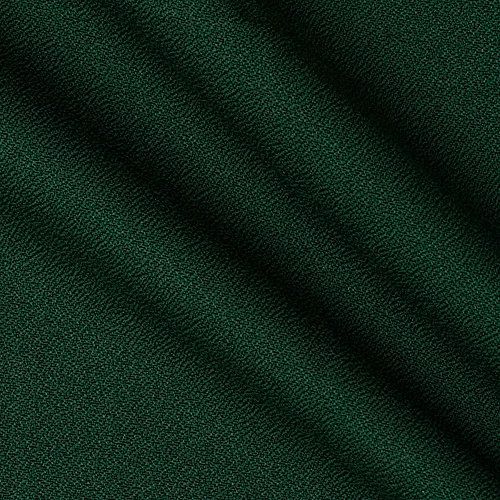When I first began sewing, one of my greatest challenges was understanding the many differences between the fabrics I saw at my local craft store. I was quickly drawn towards woven fabrics since they are excellent for quilting, making clothing, and many other projects I like to undertake as a sewing enthusiast. But what are the most common woven fabric types and how can you tell them apart?
“Woven fabric” refers to any variety of fabric that is created by weaving together individual threads. It comes in many types, ranging from the ever-popular cotton broadcloth to more specialized fabrics like velvet or terry cloth. Generally, the many varieties of woven fabric can be organized into four classifications – plain weave fabrics, pile weave fabrics, satin weave fabrics, and twill weave fabrics.
In this article, we’ll explain exactly what each of these four classifications of the woven fabric means. We’ll also discuss fourteen of the most common examples of woven fabric you’re likely to encounter at your local fabric store and what they are typically used to make. Before you know it, you’ll be an expert on woven fabrics and create amazing projects on your own.

What is Woven Fabric?
To put it simply, woven fabric refers to any fabric made by weaving together individual threads or yarn to create a finished product. These fabrics are versatile and are used to create anything from clothing to furniture, home decor, or virtually any other fabric product. You’d be astonished to know how many woven materials you encounter daily!
Traditionally, woven fabrics were created by hand by stretching threads vertically across a loom and then passing threads through these strands horizontally. However, modern manufacturers have automated this process and most woven fabrics are now mostly made by machines. This creates a very uniform and even material that is typically durable and long-lasting.
This production technique is very different than non-woven fabric alternatives. Most non-woven fabrics are made by binding together threads using chemicals, heat, or other manufacturing processes. Most non-woven fabrics are made from synthetic materials, while woven fabrics can be made from virtually any type of fiber.
What Are the Classifications of Woven Fabric?

Though woven fabrics are all made by weaving together individual threads, there are still various weaving techniques that can be used. Each method produces a different type of fabric altogether, which results in a great deal of variation between each type of woven fabric. In general, woven materials will fall into one of four categories: plain weave, pile weave, satin weave, or twill weave fabrics.
Plain Weave
Plain weave fabrics are the simplest example of a woven material and are the most common option that you will see at your local craft store. These fabrics are made by passing one strand of yarn over another without adding many extra steps. This generally produces thin and smooth fabrics that are very versatile to work with.
Pile Weave
Pile weave fabrics are woven so that extra-long loops of fabric sit on top of the material to give it added thickness. These fabrics are typically dense and plush to the touch, commonly having raised ridges along their surface. Many home carpets or rugs are examples of a pile weave fabric, though a particularly thick version.
Satin Weave
Satin weave is the category of woven fabric that is particularly known for being smooth and having a silky-looking surface. The underside of the fabric is usually very plain and dull in comparison. The shiny look of this fabric is due to the unique way in which its fibers are woven together, in which four vertical threads are floated over a single horizontal thread and vice versa.
Twill Weave
Twill weave has a distinct appearance and is known for the characteristic texture made by the diagonal ribs raised across the fabric’s surface. This unique weave is created by weaving a horizontal thread over one or more vertical threads, then back under two or more vertical threads to create a step-like pattern. By repeating this over and over again, you create the unique effect that twill weave is known for.
The 14 Woven Fabric Types You Should Know
While many different woven fabrics are available on the market today, some are more common than others. Below are fourteen of the most common woven fabrics you may encounter daily.
1. Chambray
 Chambray is an example of a plain weave cotton fabric created by weaving dyed fibers in one direction and white fibers in the other. Typically, the dyed fibers will be a light blue, helping to give this fabric the appearance of lightweight denim. However, the color certainly isn’t limited to blue; you might find chambray in many different shades.
Chambray is an example of a plain weave cotton fabric created by weaving dyed fibers in one direction and white fibers in the other. Typically, the dyed fibers will be a light blue, helping to give this fabric the appearance of lightweight denim. However, the color certainly isn’t limited to blue; you might find chambray in many different shades.
Chambray is a thin and comfortable material, which is why it is commonly used to make button-down shirts for both men and women. It is also a favorite for making work clothes since it is durable but won’t cause the wearer to overheat. All-in-all, chambray is a simple yet functional fabric that is an excellent choice if you want to sew your own clothes.
2. Chenille
 Chenille fabric gets its name from the French word for ‘caterpillar,’ which is what the surface of this pile-weave fabric is said to look like. Chenille is specifically made by twisting together multiple strands of yarn before weaving them together. This gives the fabric the characteristic ridges that have earned it its name.
Chenille fabric gets its name from the French word for ‘caterpillar,’ which is what the surface of this pile-weave fabric is said to look like. Chenille is specifically made by twisting together multiple strands of yarn before weaving them together. This gives the fabric the characteristic ridges that have earned it its name.
Chenille is a very soft fabric that is most commonly made from cotton but can also be found in acrylic, rayon, or other synthetic options. You’ll typically see chenille fabric used for bedding, carpets, upholstery, and even letters on the letterman jackets commonly worn by athletes.
This means that chenille fabric is a bit more specialty and won’t be seen as commonly as many others on this list. Even then, you should try this fabric at least once to see just how unique it is for yourself.
3. Chiffon
 Another example of a plain-weave fabric, chiffon is known for its sheer look and lightweight feel. It is a very gauze or mesh-like fabric that is often considered elegant and luxurious. It gets its unique finish thanks to the s- and z-shaped twists that the fabric’s threads are shaped into as they are woven.
Another example of a plain-weave fabric, chiffon is known for its sheer look and lightweight feel. It is a very gauze or mesh-like fabric that is often considered elegant and luxurious. It gets its unique finish thanks to the s- and z-shaped twists that the fabric’s threads are shaped into as they are woven.
Originally coming in natural fibers such as silk, most chiffons today are synthetic and are woven from rayon or polyester threads. This is because natural silk is very expensive and synthetic fibers are an affordable alternative. You’ll likely see chiffon fabrics used to make women’s formalwear, especially as an overlay on dresses and skirts.
If you’re looking to make clothing to wear for special occasions, chiffon is a great option to consider. We also recommend it if you’d like to make your own sheer curtains for your home since it can add a pop of color while allowing light to filter through.
4. Corduroy
 Corduroy is an example of a pile weave fabric that gets its plush feel from cut fibers that form ridges along its surface. The distinctive lines along the fabric’s surface give it an almost velvet-like feel. This unique characteristic is why corduroy is often referred to as “rib velvet” throughout the world.
Corduroy is an example of a pile weave fabric that gets its plush feel from cut fibers that form ridges along its surface. The distinctive lines along the fabric’s surface give it an almost velvet-like feel. This unique characteristic is why corduroy is often referred to as “rib velvet” throughout the world.
Corduroy is a very strong and durable fabric that holds well to everyday wear and tear.
You’ll often see corduroy fabric used to make clothing such as pants, jeans, or even shirts. You may also see it being used to make warm outerwear like jackets.
For a simpler project using corduroy, consider using it to make throw pillows for your bed or couch at home. Corduroy is also a fun option for making pants or even a cute pair of overalls to wear as the weather gets cooler outside.
5. Cotton Broadcloth
 Cotton broadcloth is probably the most widely-available plain weave fabric. It is made from cotton fibers that are tightly woven to give it a flat, smooth finish. The cotton fibers are durable and can be dyed to make endless combinations of colors and patterns – ensuring that there is a woven option for whatever project you might be working on.
Cotton broadcloth is probably the most widely-available plain weave fabric. It is made from cotton fibers that are tightly woven to give it a flat, smooth finish. The cotton fibers are durable and can be dyed to make endless combinations of colors and patterns – ensuring that there is a woven option for whatever project you might be working on.
Cotton broadcloth is often a top fabric for quilting projects since it can be easily cut and sewn into many different designs. It is also commonly used to make clothing, from button-down shirts to skirts. Around the house, you might also consider using cotton broadcloth to make curtains, tablecloths, or even bed sheets.
6. Crepe
 You’re probably familiar with the French word “crepe” which refers to the country’s signature thin, delicate pancakes. It’s no surprise, then, that crepe fabric is known for being extremely thin and delicate. Specifically, crepe fabric is a satin-weave material that is famous for its signature crinkly, puckered surface.
You’re probably familiar with the French word “crepe” which refers to the country’s signature thin, delicate pancakes. It’s no surprise, then, that crepe fabric is known for being extremely thin and delicate. Specifically, crepe fabric is a satin-weave material that is famous for its signature crinkly, puckered surface.
The unique texture of crepe fabric comes from its threads, which are twisted before they are woven together. These threads can be made of several types of fibers, ranging from silk to wool or synthetic alternatives. You’ll often see crepe fabric being used for clothing, especially to make women’s dresses or shirts.
7. Denim
 One of the most common twill weave fabrics you’ll encounter daily is denim. This strong and durable fabric is typically made by weaving together colored cotton strands (usually blue) with white threads that run in the opposite direction. This is what gives denim its traditional blue-speckled appearance.
One of the most common twill weave fabrics you’ll encounter daily is denim. This strong and durable fabric is typically made by weaving together colored cotton strands (usually blue) with white threads that run in the opposite direction. This is what gives denim its traditional blue-speckled appearance.
Denim comes in various weights and thicknesses depending on how durable you need the fabric to be. Modern denim will often have other fibers woven into it, such as stretch yarn or elastic. Blue jeans are the most common clothing made from denim, but you’ll also see them used for shirts, dresses, and even jackets.
8. Flannel
 Flannel fabrics are typically made with either plain weave or twill weave techniques. This weave’s cotton, wool, or synthetic threads are woven loosely together. This helps give the fabric a soft feeling while also being very warm.
Flannel fabrics are typically made with either plain weave or twill weave techniques. This weave’s cotton, wool, or synthetic threads are woven loosely together. This helps give the fabric a soft feeling while also being very warm.
You can often recognize flannel by its characteristic plaid or checkered finish, though solid-color options also exist. Since flannel is extremely soft, it is often a popular choice for clothing and bedding. You’ll see flannel being used as a lining for jackets or other pieces of clothing to add some extra warmth.
9. Muslin
 Muslin is a fine, plain-weave fabric that has been around for centuries. This cloth dates back to ancient India, originally handwoven and used to make women’s dresses and other everyday clothing items. A very simple and loosely-woven fabric, muslin is one of the softest and most breathable materials available today.
Muslin is a fine, plain-weave fabric that has been around for centuries. This cloth dates back to ancient India, originally handwoven and used to make women’s dresses and other everyday clothing items. A very simple and loosely-woven fabric, muslin is one of the softest and most breathable materials available today.
Some varieties of muslin are used by sewers who want to create sample versions of their projects and test the fit of their patterns. This is because muslin is often a very inexpensive fabric and is an affordable alternative for making mock-ups of your designs whenever you don’t want to waste your more expensive materials. It is also often used as a lining on other garments or as a backing for quilts.
10. Organza
 Organza is another example of a plain weave fabric with a lightweight and sheer appearance. Though they were originally made from silk, most modern organza fabrics are made with synthetic fibers. It is a very strong fabric that is affordable and versatile to work with on many sewing projects.
Organza is another example of a plain weave fabric with a lightweight and sheer appearance. Though they were originally made from silk, most modern organza fabrics are made with synthetic fibers. It is a very strong fabric that is affordable and versatile to work with on many sewing projects.
Organza is a great option for creating garments that need many layers of fabric since it is lightweight and can easily be stacked. Clothing makers typically use this fabric to create poofy dresses with many underlayers. You’ll also often see organza in ballgowns, bridal dresses, and other formal pieces.
11. Seersucker
Seersucker is another example of a plain-weave fabric, even though it does not have a smooth and flat surface. Seersucker is famous for its wrinkled or puckered appearance, created by weaving threads together at different speeds and tensions. The characteristic wrinkles help make this fabric lightweight and perfect for wearing in hot summer since the puckers help keep the fabric raised off your skin and allow airflow.
Seersucker is mostly made from cotton fibers and has alternating pastel and white pinstripes or checkers across its surface. You’ll likely see this fabric used to make summer clothing, ranging from men’s suits and shorts to shirts and dresses.
12. Terrycloth
Chances are you use terrycloth frequently in your everyday life since it is the most common fabric used to make bath towels and washcloths. This fabric is an example of a pile weave material and gets its bulk from threads that are arranged to create individual loops all across the surface of the material. Terrycloth is typically made from 100% cotton since this fiber is absorbent and works well to dry off after a shower.
You might also see terrycloth being used to make robes, swimsuit coverups, hair wraps, or other garments that are intended to absorb water. You may also see it being used to make children’s diapers that can be washed and reused.
13. Tweed
Tweed fabric is typically made from wool, giving it a coarse woven texture. It can be woven with a plain or a twill weave, depending on the manufacturer and the overall look the designer was aiming for. Color variations within tweed are usually subtle and come from different shades of wool woven together.
Tweed fabrics are commonly seen in outdoor clothing and garments meant to withstand cold or wet weather conditions. People throughout history have worn tweed jackets while hunting, horseback riding, or participating in other outdoor activities. Tweed jackets are also a traditional staple of professors and other academics – especially in films and television shows.
14. Velvet
Velvet is one of the most common examples of a pile weave fabric and is known for its thin yet plush feeling. It is smooth to the touch and can be made from silk, cotton, or synthetic fibers. Velvet is also known for its shiny appearance and is generally considered a luxurious material to work with and wear.
Velvet is often used on clothing and upholstery, often as trim or in scrolling designs across the fabric’s surface. Around the winter holidays, velvet is commonly used in home decor ranging from curtains to ribbons on trees or wreaths. You’ll also see velvet being used as a lining on many home products, including jewelry boxes, display cases, or any containers meant to hold delicate belongings.
Conclusion
As you venture farther into the world of sewing, you can rest assured that you now know everything you need to know about the most common woven fabrics available on the market. Keep this guide handy next time you head to your local fabric store and see which of these fabrics you can find. With any luck, you’ll find some exciting new fabric options to try for your next project!